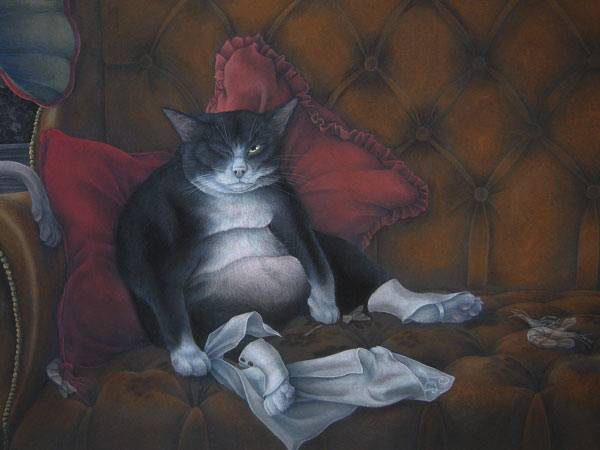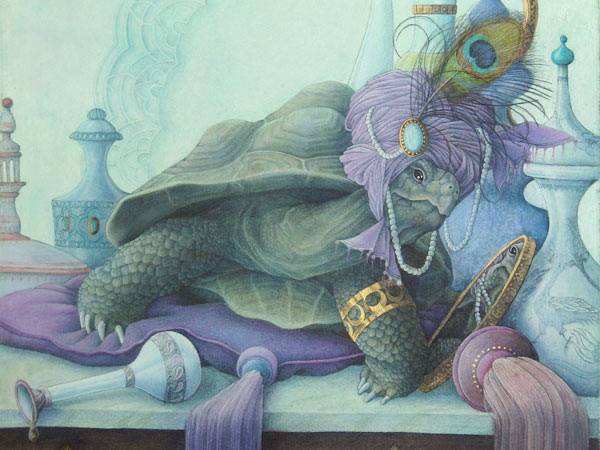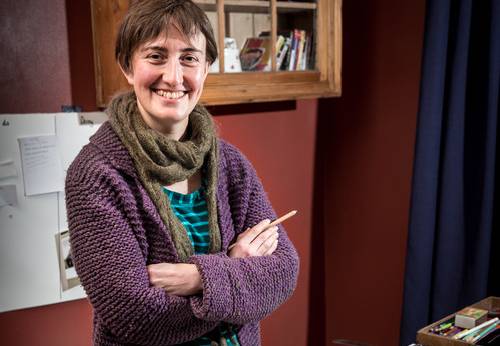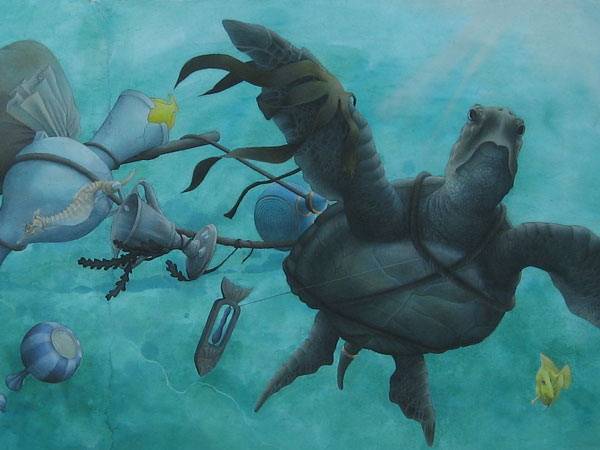Kate Leiper is an artist and children’s illustrator based in Edinburgh. Her work has a style of its own, instantly recognisable, highly desirable and having a loyal and enthusiastic following. Her work is figurative and for the most part based upon narrative. She is particularly inspired by Scottish legends, folklore and fairytales. Kate works on paper using mainly pastel, ink, acrylic paint, gold leaf and collaged materials. Great and small creatures are the focus of her immaculate mixed media works. She has been commissioned for projects by the Scottish Storytelling Centre and the Royal Lyceum Theatre. She created the stunning artwork for the critically acclaimed ‘An Illustrated Treasury of book Scottish Folk and Fairy Tales’ written by award-winning author, Theresa Breslin. Kate Leiper visited Pakistan to attend LLF-2016 and made illustrations of the stories told by Ian Stephen in the session ‘Storytelling: Oral Traditions in Scotland and Pakistan’. In an exclusive interview with Weekend magazine she talks about her career, work, inspirations and many more. Read on to know more about her!
Faizan Hussain: First of all, how was your trip to Pakistan?
Kate Leiper: Lahore was amazing! It was the first time that I'd ever visited this part of the world and being a visual person, I gorged myself on all the fantastical new sights, colours and textures. I was met with such friendliness and kind hospitality by the people there and the food I ate was just delicious. I hope that I can go back one day.
FH: Tell us a bit about yourself. How did your journey in art begin?
KL: I can't remember a time when I didn't draw. As a child I used to pester my dad to bring me scrap paper from his office which I would then go through at an alarming rate. Family pets were often engaged as models willingly or otherwise. My parents always encouraged me to draw and nurtured my interest in art by regularly taking me to see exhibitions and galleries. It was only when I went to secondary school that I experienced some resistance to the idea of pursuing art as a career, the suggestion being made that it would be impossible to get a "proper job". However I was lucky enough to have some very enthusiastic art teachers who inspired me to continue with my art studies and apply for a place at art school.
FH: What is your preferred medium of painting/illustration?
KL: I work mainly with chalk pastel on paper. The paper is often prepared beforehand with ink or watercolour and any gold detailing is done in acrylic paint or ink.
FH: How do you choose the subject of your painting?
KL: Through my artwork I aim to create a visual narrative and am particularly drawn to stories which portray some aspect of life experience common to us all. I use animals as my main subject matter as they provide an immediate connection to a preconceived set of characteristics (similar to the animals in Aesop's Fables). Throughout time and all over the world people have projected human qualities onto animals. Of course, these characteristics may vary from culture to culture, but the concept of anthropomorphism is a universal one. Through the pose of my main animal subject and use of symbolic objects and imagery related to the story, I aim to catch the viewer's attention and draw them in to study the image more closely. It doesn't matter to me if the viewer sees a story which is different to the one I'm trying to tell. I'm much more fascinated by how people relate to the imagery and seek out their own tale.
FH: Whatever you draw, how much it comes from imagination and how much from research?
KL: Ooooh, this is impossible to quantify. Research can allow you to dig deeper into your imagination and yet through the imagination you are directed to new lines of research.
FH: When you illustrate a children’s book, how much freedom do you get from a publisher?
KL: This depends on the brief from the publisher. Some publishers give you a lot of freedom while others have a more set idea of what they are looking for.
FH: Where do you take inspiration for storytelling pictures?
KL: I find inspiring stories in all sorts of places. There are oral stories, printed stories, stories in ballads, poems and song lyrics, stories I've overheard and those I've collected word-of-mouth but the best are stories that are gifted to me, told because the teller believes that it will touch my soul in some way.
FH: How do you feel when you look at the finished book?
KL: A bit weird! It's pleasing to see the final outcome after months of work but it's also strange to see the illustrations in book form. The printed versions of my artwork have a different quality to them (slightly different colours, texture and scale), plus they are in the 3-dimensional form of a book. It just takes me a little time to get used to and reacquaint myself with the work in its new appearance.
FH: Tell us something about your needle work and patch work.
KL: I don't like having idle hands so I find that needlework, patchwork and knitting are great activities to relax my mind yet still give my hands something to do. It's also a good excuse to make presents for my friends and family.
FH: Do you have a daily routine that gets you ready for being creative?
KL: A mug of strong coffee first thing in the morning!
FH: When you have a creative block is there anything you do to remedy it?
KL: I usually only get creative blocks when I'm tired and I think that the worst thing you can do in this situation is to sit in front of a blank piece of paper, so I take myself away from my desk by going for a walk, having a coffee with a friend or dancing.
FH: Do you work under pressure or you believe that pressure kills creativity?
KL: For me, pressure, ie. a bracing deadline, is a double edged sword. It can provide the motivation and the means of creating a timetable in order to complete a project, however the danger comes when there is too much and it causes me to freeze. This is a horrible feeling which I can only describe as a tsunami about to crash down on my head and wash me away.
FH: How has your style changed over the years?
KL: I'm sure that it probably has, although it's always hard to plot the changes in your own work. I probably spend a lot more time at the planning stages which may mean that I consider composition more intently. I think that my work has also possibly become more intricate and detailed as I've become more experienced in handling the drawing materials.
FH: Since your trip, is there anything regarding Pakistan that you'd like to find out more about?
KL: Yes I want to know more about the book illustration scene in Pakistan and about traditional miniature painting.
FH: What is your dream project?
KL: An illustration project with no bracing deadlines!.....ahhh, but would I finish it?...
FH: Do you have any favourite thing to draw?
KL: Seals. I love the way that they are so cumbersome and ungainly on land and yet transform into the most graceful of dancers underwater.
FH: Any advice for younger artists?
KL: Keep observing and keep drawing.









